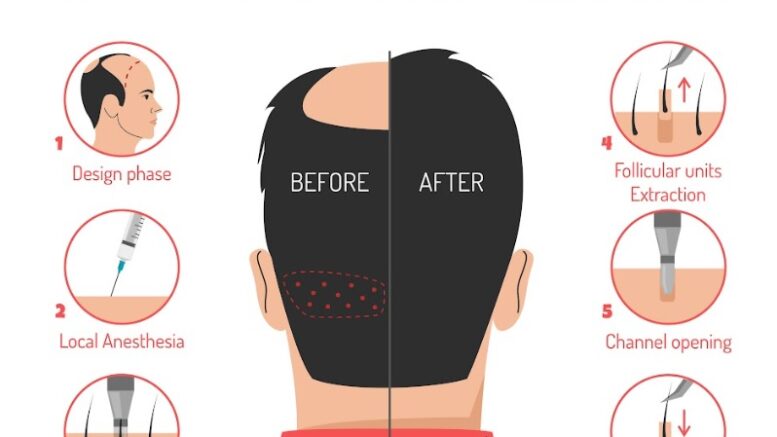Follicular unit extraction (FUE) is a hair transplant procedure that extracts individual hair follicles from your scalp area that’s usually resistant to hair loss and plants them into an area with less or no hair. During this procedure, an experienced surgeon extracts hair follicles with the help of micro-punches.
The FUE Hair Transplant Process
The FUE hair transplant procedure involves several steps until you attain your desired look. You must first book an appointment with your preferred doctor to assess your scalp and determine the way forward. Then, your doctor will schedule the date you’ll undergo the procedure and the recovery.
Apart from assessing your scalp, your surgeon will discuss what FUE entails. They’ll disclose the risks, success rate, after-transplant care, and the FUE hair transplant cost. At this point, you’ll get an opportunity to ask vital questions about the procedure before proceeding.
It’s important to mention that the success of your procedure partly depends on how experienced your doctor is in the technique. Therefore, researching the most reputable surgeons experienced and skilled in hair grafting is essential.
The Recovery Period
Regarding the procedure, recovery is among the most crucial steps. A slight mistake during the recovery period can affect the hair growth rate, resulting in a failed process. Fortunately, the chances of the procedure failing are very low or eliminated if done correctly.
Suppose you’re looking forward to undergoing an FUE hair transplant. In that case, continue reading to understand how to take care of your scalp after the procedure for favorable results.
Immediately After The Surgery
Your surgeon will typically remove the bandage to examine your bulbs a day after the surgery. Then, they’ll apply the first shampoo to teach you how to clean the grafted area correctly. However, this procedure isn’t performed in all clinics, as some only give you directions to follow. You can start cleaning your head gently after three to four days and avoid showers or submerging the head in water for the first month.
It’s vital to adhere to your doctor’s advice regarding post-procedure care. The guidelines typically include avoiding aspirin since it thins the blood and can interfere with healing and the hair growth rate.
The First Few Days
While you might return home immediately after the hair transplant surgery, resting for several days is advisable. Strenuous activities can interfere with your healing, affecting the procedure’s success rate. You should avoid scratching the harvesting and grafting area during the first few days to avoid damaging it. In addition, you may need to stay clear of sexual intercourse for a while since it can increase blood temperature in the treated area, causing bleeding.
Your doctor will also advise you to avoid too much heat, cold, or sweating since it can interfere with the healing, hence the need to stay indoors for the first few days of the procedure. If going out is inevitable, put on a loose-fitting hat to avoid direct sunlight.
It’s also advisable to prevent the grafts from getting in contact with other materials to avoid infections. You should also practice new sleeping positions, like semi-sitting, during the first two to three nights. This sleeping position prevents forehead swelling and the grafts from coming into contact with bedding.
Swelling above the eyebrows might also occur during the third or fourth day after the procedure. To prevent this or reduce the swelling, place a washcloth with ice cubes on the forehead or wear a foam wrap to prevent the swelling from spreading to the eyes.
After A Week To A Month
After a week, you’ll notice the scabs falling off during showers. This is when you begin to experience itchiness. Suppose your doctor didn’t provide you with an anti-irritation cream. You can use anti-irritation products for babies to soothe the itching and prevent over-dryness.
You should never use aggressive hair products like gels and colorings. Combs and brushes are also prohibited during this period.
After A Month
A month after the hair transplant, the implanted hair will begin to fall out. This is normal and shouldn’t scare you. Soon after the falling out, white spots will start to form and later open up to allow new hair growth. From there, new hair will begin growing, and the development will be visible after eight months to a year.
Styling The Hair
While you might be eager to style your new hair, taking precautions is advisable. You should never use a razor or disturb hair roots in the first six months. Hair dryers are prohibited until the scalp is completely healed.
Conclusion
The success of an FUE hair transplant depends on post-procedure care. If you take good care of your donor and recipient areas, your scalp will heal fast. However, if you engage in prohibited activities, like washing the treated area incorrectly, you’ll interfere with the healing procedure and the growth rate. Therefore, it’s important to follow the specific post-operative care instructions provided by your surgeon to avoid complications and ensure the best possible results.
